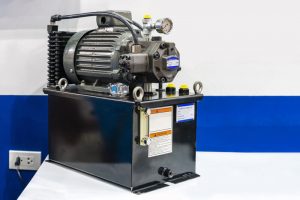Call us on +44 (0)1327 842808 |
Published on 27 February 2022
Choosing the right-sized hydraulic tank is essential for all commercial vehicle applications. As a general rule, hydraulic tanks should be around 2.5 x the pump(s) flow, however, the correct sizing varies depending on the intended usage of the system; as well as whether the system uses an open or closed circuit.
Hydraulic tanks store hydraulic fluid and prevent air from building up in the system which can potentially lead to issues. Instead of the air being allowed to create problems within the system, hydraulic tanks are designed so that air rises to the top of the hydraulic oil, allowing it to blow out through the breather cap. Without the right-sized hydraulic tank not only can this process not take place, possibly causing system failures, but the tank won’t enhance the performance of your operations.
So how do you identify what size of hydraulic tank you need? The most important consideration is your system’s specifications, requirements, and intended application. To fully understand the right size of hydraulic tank you need, you should speak to an engineer who understands hydraulic systems and can advise on the best type and capacity options.

Many people believe the larger the size of the reservoir the better. The logic is the larger the size of the hydraulic tank, the longer the dwell time the oil has to expel contaminants. As we mentioned above, however, there are rules of thumb to consider for the sizing of hydraulic tanks. When considering the right size for most commercial vehicle applications, the minimum size for the reservoir should be around 2.5 x the pump(s) flow.
However, this direction is not enough information to base your decision on. You must also assess whether the return flow is larger than that of the previous pump flow, for example. Accessories can also be added to the tank which adapt and improve the system, such as filter assemblies, filter condition indicators, suction and return line fittings, level and temperature gauges. These additional features will also affect the size of the hydraulic tank your organisation needs.
Where the tank is acting as a reservoir for equipment, such as a lorry loader crane, to give sufficient cooling and deaeration of the oil a tank capacity of 3x pump flow is desirable. PCM tanks are designated to indicate the working (“useable”) volume, not the total volume. This means that if a tank is designated as 100 litres, the total volume could be 125 litres and this allows for 10% air space and 15% extra oil to keep the outlet covered with oil in the case of a tipper when the ram is fully extended. If, therefore, the tank is on a tipper application the volume of the fully extended ram should be known.
One of the main factors that will affect the correct sizing of your hydraulic tank is whether the system is an open or closed circuit. Open circuit hydraulic tanks’ capacity needs to be around 3-5 x the pump flow rate per minute. You should also include a 10% air cushion in this calculation. This is relatively simple to achieve when operating a stationary hydraulic tank, however, the weight and space constraints of mobile units make this more challenging. That’s why a 2 x the pump flow rate capacity is acceptable for mobile hydraulic tanks.
For closed-circuit systems, you should lower the tank volume to avoid any excess fluid in the reservoir. This is because a tank volume that’s 3-5 x the pump flow rate circulating the loop of a closed-circuit tank may increase the temperature of the fluid, slow operations, and cause excess air to build up.
Also known as reservoirs, hydraulic tanks offer a centralised source for the hydraulic fluid typically found throughout a standard commercial vehicle hydraulic system. The inlet fluid transfers through the pump, or pumps, provided by the hydraulic tank while the return flow is retained by the system. If the system installed isn’t the right size, your operations will be impacted and the risk of a system failure increases.
When appropriately sized and fitted with the necessary accessories and assemblies, hydraulic tanks can assist application in varying ways. They can cool the fluid in the system, detect and remove contaminants from the fluid, and ensure water vapours are removed from the liquid. To ensure you fit the right hydraulic tank for the job and get the most out of your hydraulic system, you should contact industry-leading professionals.
For over 30 years PCM Handling has delivered specialist equipment to the transport industry across the UK. From hydraulic oil tanks and commercial vehicle hydraulic equipment to crane attachments, our team’s expert knowledge ensures you always get the right system for your requirements.
Don’t leave your hydraulic oil tanks’ size down to guesswork, get in touch with our team today. We can assess your circumstances and guide you towards the right hydraulic system for your business. Call us now on 01327 842808 or visit our contact page to fill in an enquiry form today.
Fill in the form below and a member of the team will be in touch with you shortly.
© 2025 PCM Transport and Handling
Web Design and Marketing by Loop Digital